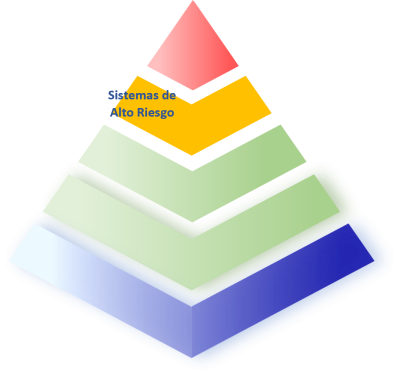
Chapter III of Artificial intelligence act (EU) 2024/1689 regulates High Risk Artificial Intelligence System. These are those systems which may affect people’s health or fundamental rights and must therefore fulfil specific requirements and obligations in order to enter the European Union market; they are also subject to supervision by administrative authorities.
For market entry they require, as a general rule, technical and legal self-assessment, in accordance with the procedure of Annex VII. In the harmonised sectors of Annex I, Section A, they shall be governed by their special rules.
|
|
Risk management systems (Article 9) |
|
|
|
Data and Data Governance (Article 10) |
|
|
|
Technical documentation (Article 11) |
|
|
|
Retention of records (Article 12) |
|
|
|
Transparency (Article 13) |
|
|
|
Human supervision (Article14) |
|
|
|
Accuracy solidity and cybersecurity (Article 15) |
The supervision, inspection and sanction in the post-marketing will be carried out by different Market Surveillance Authorities (AVMs), according to the object and effects of the AI system: AESIA, AEPD, Banco de España, General Council of the Judiciary and the AVMs of the harmonized sectors of Annex I, Section A of the Regulations.
 |
AI system that regulates traffic in a city by adapting the state of traffic lights according to traffic and pedestrians. |
|
 |
AI system that analyzes in real time the activities of the students during an exam in order to know if they are copying. |
|
 |
AI system that constantly and autonomously analyzes the quality and potability of a city’s water, making the necessary corrections to reach its potability. |
|
 |
A child toy that communicates with the child by voice and speaks with him or her in order to encourage when they are sad. |
|
This annex lists various EU harmonisation laws based on the new legislative framework. These are legislative acts that cover a wide range of areas and are aimed at standardising standards in all Member States.
Product safety components, only in those products already subject to third-party evaluation in harmonised sectors:
|
|
Industrial (machines, elevators, protective systems -epis-, pressure equipment or gas appliances) |
|
|
|
Toys |
|
|
|
Recreational boats |
|
|
|
Radio equipment |
|
|
|
For transportation by cable |
|
|
|
Healthcare, including in vitro diagnostics |
|
|
|
Transport (aviation, railway, marine equipment and approval of 2 and 3-wheel motor and agricultural vehicles) |
High-risk AI systems referred to in Article 6, paragraph 2.
| 1. Biometrics not prohibited: AI systems that remotely identify, categorize based on sensitive characteristics, or recognize emotions. | ||
|
2. Critical infrastructures: whether they are safety features in road traffic infrastructures or in the supply of gas, water, heating or electricity. |
||
|
3. Education and vocational training: If you decide to admit, evaluate the learning or level of education you will receive, or if you detect prohibited behaviors on exams. |
||
| 4. Employment, management of workers and access to self-employment: If you decide to hire, filter and evaluate candidates, or if you decide working conditions, tasks, performance, promotions or layoffs. | ||
|
5. Access to and enjoyment of essential private services and essential public services and benefits: such as health care, including the reduction or withdrawal of such services. In addition, if you assess credit worthiness or assess risks and set prices on life and health insurance. Also, if you evaluate emergency calls and prioritize services. |
||
|
6. Guarantees of compliance with the Law: If you evaluate evidence, or the risk of being a victim, or of someone committing a crime. Also if you create profiles. |
||
|
7. Migration, asylum and border control management: If you help the authorities as a tool, you assess health or safety risks, or if you examine applications. |
||
| 8. Administration of justice and democratic processes: If it helps Judges to investigate or interpret facts or the Law. Also if it is used to influence the outcome of an election or the electoral behavior of voters, unless it is used to organize, optimize or structure logistics in election campaigns. |

In our News section you will find information about the most relevant events, talks and conferences in the field of artificial intelligence.

AESIA consolidates its role in Europe in promoting ethical, sustainable...

The United Nations Human Development Report recognizes the transformative potential...
We use third-party cookies for analytical purposes, in summary we only use Google Analytics cookies to analyse our traffic.